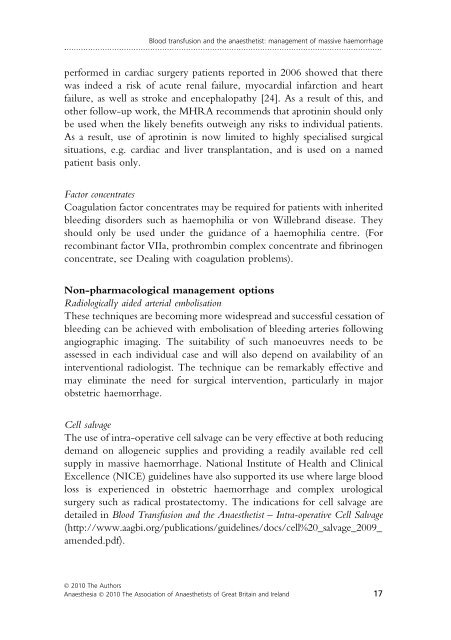Blood transfusion and the anaesthetist: management of ... - aagbi
Blood transfusion and the anaesthetist: management of ... - aagbi
Blood transfusion and the anaesthetist: management of ... - aagbi
You also want an ePaper? Increase the reach of your titles
YUMPU automatically turns print PDFs into web optimized ePapers that Google loves.
<strong>Blood</strong> <strong>transfusion</strong> <strong>and</strong> <strong>the</strong> anaes<strong>the</strong>tist: <strong>management</strong> <strong>of</strong> massive haemorrhage<br />
.....................................................................................................................................<br />
performed in cardiac surgery patients reported in 2006 showed that <strong>the</strong>re<br />
was indeed a risk <strong>of</strong> acute renal failure, myocardial infarction <strong>and</strong> heart<br />
failure, as well as stroke <strong>and</strong> encephalopathy [24]. As a result <strong>of</strong> this, <strong>and</strong><br />
o<strong>the</strong>r follow-up work, <strong>the</strong> MHRA recommends that aprotinin should only<br />
be used when <strong>the</strong> likely benefits outweigh any risks to individual patients.<br />
As a result, use <strong>of</strong> aprotinin is now limited to highly specialised surgical<br />
situations, e.g. cardiac <strong>and</strong> liver transplantation, <strong>and</strong> is used on a named<br />
patient basis only.<br />
Factor concentrates<br />
Coagulation factor concentrates may be required for patients with inherited<br />
bleeding disorders such as haemophilia or von Willebr<strong>and</strong> disease. They<br />
should only be used under <strong>the</strong> guidance <strong>of</strong> a haemophilia centre. (For<br />
recombinant factor VIIa, prothrombin complex concentrate <strong>and</strong> fibrinogen<br />
concentrate, see Dealing with coagulation problems).<br />
Non-pharmacological <strong>management</strong> options<br />
Radiologically aided arterial embolisation<br />
These techniques are becoming more widespread <strong>and</strong> successful cessation <strong>of</strong><br />
bleeding can be achieved with embolisation <strong>of</strong> bleeding arteries following<br />
angiographic imaging. The suitability <strong>of</strong> such manoeuvres needs to be<br />
assessed in each individual case <strong>and</strong> will also depend on availability <strong>of</strong> an<br />
interventional radiologist. The technique can be remarkably effective <strong>and</strong><br />
may eliminate <strong>the</strong> need for surgical intervention, particularly in major<br />
obstetric haemorrhage.<br />
Cell salvage<br />
The use <strong>of</strong> intra-operative cell salvage can be very effective at both reducing<br />
dem<strong>and</strong> on allogeneic supplies <strong>and</strong> providing a readily available red cell<br />
supply in massive haemorrhage. National Institute <strong>of</strong> Health <strong>and</strong> Clinical<br />
Excellence (NICE) guidelines have also supported its use where large blood<br />
loss is experienced in obstetric haemorrhage <strong>and</strong> complex urological<br />
surgery such as radical prostatectomy. The indications for cell salvage are<br />
detailed in <strong>Blood</strong> Transfusion <strong>and</strong> <strong>the</strong> Anaes<strong>the</strong>tist – Intra-operative Cell Salvage<br />
(http://www.<strong>aagbi</strong>.org/publications/guidelines/docs/cell%20_salvage_2009_<br />
amended.pdf).<br />
Ó 2010 The Authors<br />
Anaes<strong>the</strong>sia Ó 2010 The Association <strong>of</strong> Anaes<strong>the</strong>tists <strong>of</strong> Great Britain <strong>and</strong> Irel<strong>and</strong> 17

















